Class 12 Project Presentations Review
By Christine Polyblank
Last Wednesday and Thursday evening, everyone was invited to hear the Class 12 students present their projects in the hall. Some of the students in Class 12 have been in the school for as many as 15 years – and in the audience was at least one Kindergarten teacher who came to see how their ‘tinies’ had developed over the 12 classes. While the parents had originally brought the children to the school, it was the children who had kept them here for all these years. And here they were one last time, sunny smiles behind the kitchen hatch, offering refreshing teas and delicious cakes throughout the evening.
Upper School teacher Csaba Dolak reminded us of the three major events that crown Waldorf education: the cultural trip to Italy, a major play and the projects.
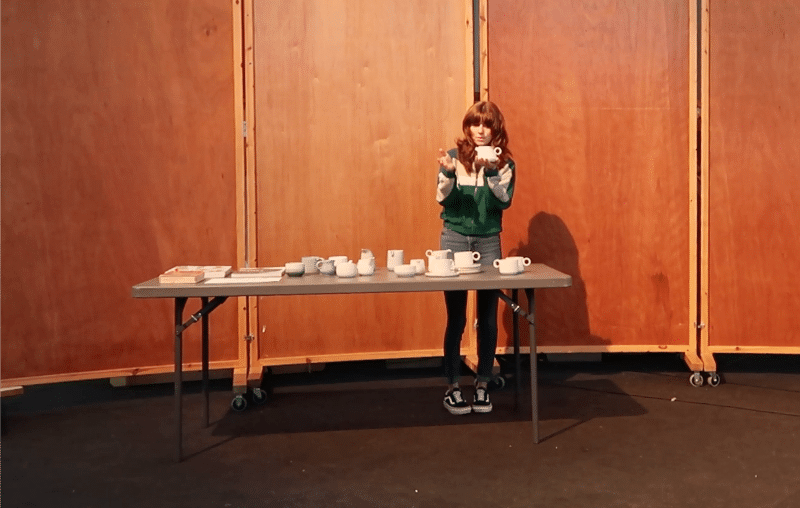
First up was Lyra. Describing herself as someone too often seeking perfection, she hoped to investigate this through taking up Pottery. Here she soon came upon the words of Bernard Howell Leach – ‘the Father of British studio pottery’ – which got her thinking: ‘Perfection can be a fetish’. She apprenticed herself to a local, excellent potter who took her step by step through from the basic cylinder, where potting begins, to a whole fully glazed tea service. Along the way mistakes were made and here the lesson was to ‘trust the clay and get to know yourself’. We in the audience learnt a lot too. We can now look at a piece of pottery and recognise its human properties: here’s the lip, there’s the foot; there’s a belly too …and a shoulder – and that sometimes the piece has a will of its own! Lyra’s presentation was both humorous and confident, with slides and a video. She had learnt about clay and also about herself: she realised that she was stronger than she had thought – and that nothing is perfect.
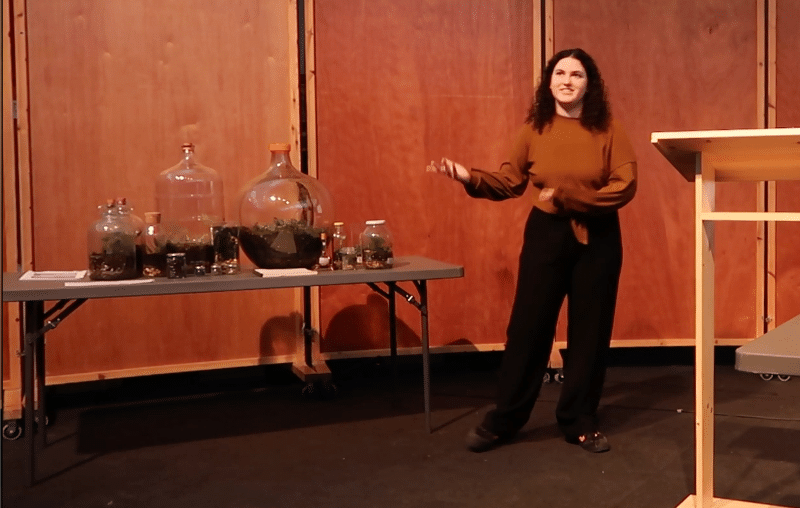
Martha was up next – and hers was a very different project. Martha’s interest was Enclosed Ecosystems. She described what is necessary to create a healthy system that could continue to function over time. Many very particular layers must be carefully built up in the chosen vessel: drainage, separation, filtration, substrate… Then come the plants – mosses and ferns maybe – then perhaps some worms or woodlice, and finally rain water. Here we learnt that some level of perfection is indeed necessary if the container is not to succumb to waterlogging, mould or other horrors. Martha showed us step by step, in a video, how she had created a large carboy. We were then invited to investigate a collection of Enclosed Ecosystems of various shapes and sizes that she had created along the way. Another confident presentation.
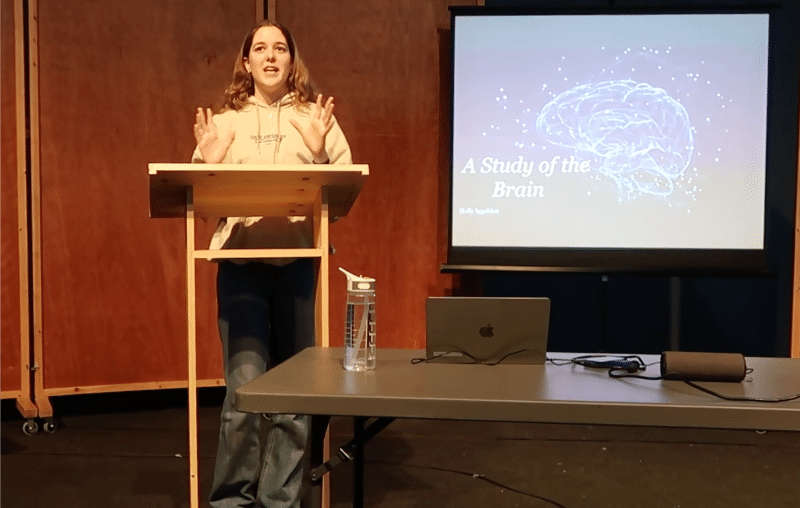
Next to make her presentation was Holly with her study of The Brain. Holly immediately spoke of her ‘love of the brain’ and her wish to understand it. But first there was the urgent question – the brain? or the mind? – neuroscience? or psychology/philosophy? In the book which she has produced, Chapter 1 deals with this conundrum. By chapter 2, the decision has been made; it deals with the history of neuroscience – a huge topic. Chapter 3 deals with the development of the brain: where are memories stored? What happens when alcohol is taken and much more. In Chapter 4 she discusses the history of disorders, mental illness and such conditions as Alzheimers and epilepsy. With many slides, Holly showed us which functions are carried by which parts of the brain. She left us with the alarming notion that, while the eyes are true, the brain makes choices as to what it registers so that reality for each of us is actually different! Holly imagines that her future might lie in neuropathic nursing. Another fascinating and confident presentation.
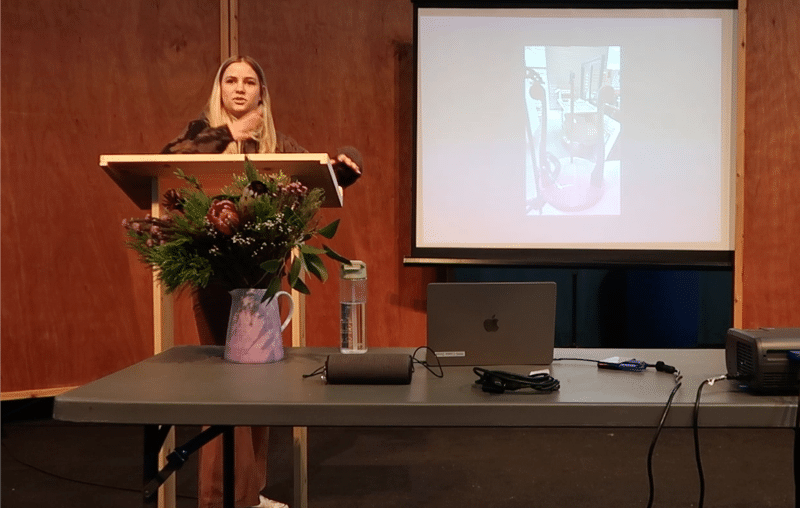
Rhiannon chose Joinery for her project. But not immediately: there was a flurry of ideas to be sorted through first. The idea of ‘fixing’ an old car proved to be just that bit too challenging and vastly expensive. Shoe-making? – no: this was going nowhere! No-one was co-operating! Then, at just the right moment, an antique, round Japanese Side Table came into view, and to make just such a neat, round, decorative little table was irresistible. A fine piece of walnut was found and tracings for the pattern begun. A new set of carving tools arrived at just the right moment from Amazon – among them a router which Rhiannon used to transfer the pattern onto the wood. Progress was slow and the challenges daunting. The maths involved in getting the legs to sit in the right place threw a final spanner in the works and help was sought. There was still much routing, carving, rounding off and oiling to be done and all in all, with the realisation that she had begun the project much too late, Rhiannon confessed to having not enjoyed any part of her project – and actually wanted to be an Estate Agent! The presentation was done with lightness and charm – much enjoyed by the audience – and the resulting almost perfect table much admired.
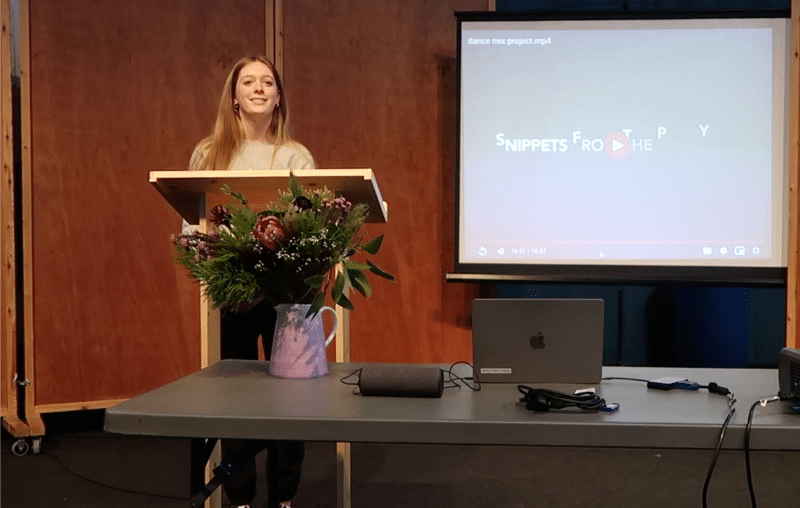
Ishbel chose Contemporary Dance for her project as, with her natural grace, she has loved dancing for most of her young life. Before choosing Contemporary Dance, she tried other styles which she described as more restrictive, such as ballet. It was the freedom of movement and expression of Contemporary Dance that helped her choose. Over recent years she has taken part in different companies as well as in many other choreographic settings with styles as varied as Avant Garde, Rambert, Hip-Hop and many more. She showed us a video in which she performed in a number of these different settings. Becoming aware of ‘politics versus rebels’ filled her with horror – for example, learning how young women in Iran are forbidden to dance freely, their dancing illegal and punishable with long periods in prison. Ishbel hopes to continue to study dance in the future and that her work will have a positive impact. Her video ended with a beautiful sunset improvisation.
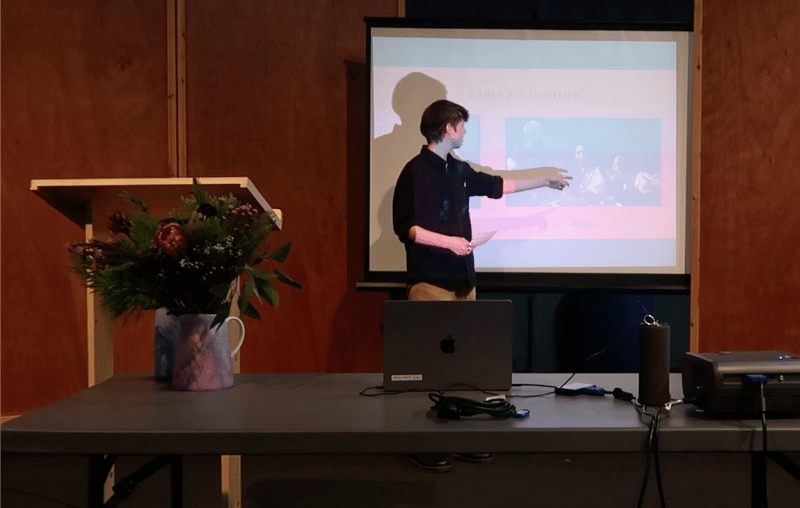
Octavia chose Baroque Painting for their project. The word actually means ‘irregular pearl’, a slightly odd or eccentric thing – and was intended to be mildly insulting. It belittled not only painting but dancing, architecture, music and sculpture. Octavia is well read, fully grasps the politics of that period and was able to share their all-consuming project with us with wit and intelligence. They gave us a lesson on how to recognise a Baroque painting and followed this with a tricky quiz!
Before choosing this subject Octavia had considered starting a small illustration business, or doing something with singing. What they learnt was that it is possible to make something you’re proud of in which you have to go out of your comfort zone before coming back into it. Would they do it again? Well no; whilst making the video they developed a taste for making videos…!
Octavia had painted an exquisite version of Caravaggio’s ‘St Francis in Meditation’ on which they had worked painstakingly for absolute months. The proof was in the video made as they painted, but often speeded up so that we would get to the end before ‘absolute months’ had passed. They also showed several fine sketches and a contemporary painting worked after the film Narcos using the same techniques.
The last word from Csaba: ‘These projects by the students of Class 12 have provided an insight into each one on their journey to becoming who they are.’
See how our education systems can nurture creativity with fascinating insights from Sir Ken Robinson.
Read MoreChildren at an international summer school in the New Forest have gained the top mark in an independent performing arts…
Read MoreThe Ringwood Waldorf School in Ringwood, Hampshire welcomed visitors and families to find out more about their alternative ‘Steiner’ approach to education last week as part of their May open day.
Read MoreWe were all marvellously entertained last Friday and Saturday by Class 8’s most amazing and thoroughly delightful presentation of Jules Verne’s ‘Around the World in 80 Days’ – based on a script which allowed for many original changes by the class.
Read MoreMindful Breathing Mindful Breathing Short Mindful Listening Friendly Wishes One Friendly Wishes Two Friendly Wishes Three
Read More